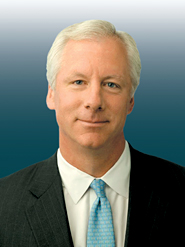Knight Capital Group is in the process of restructuring its institutional sales and trading division.
Chief executive Tom Joyce told analysts and investors yesterday that the firm is “rethinking and reconfiguring its offering” to money managers. A restructuring program, begun in the third quarter, will save between $40 million and $50 million per year in operating expenses, Joyce said.

“An uptick in institutional trading activity would be a welcome development,” Joyce said at the annual securities brokerage and market structure conference sponsored by Keefe, Bruyette & Woods. “Until that time, however, we will continue to focus on getting the right client offering and staffing levels in order to sustain profitability.”
Knight’s institutional business took in $408 million in the first nine months of the year, while booking $435 million in operating expenses. The resultant pre-tax loss included a write-off in the third quarter of $24 million due to redundancies. Since then, senior managers such as Greg Voetsch, head of institutional equities, and Chris Sula, head of cash trading, have left the firm.
Knight employs 361 staffers in its institutional sales and trading group, which includes both fixed income and equities employees. The firm employs 222 staffers in its market making group.
Knight’s market making group is now the largest in the firm, contributing $172 million in operating profits on $517 million in revenues in the first nine months of the year. The business has grown steadily over the past three years, as Knight has branched out into options and exchange-traded funds. The firm also has plans to move into proprietary trading “across asset classes and regions,” according to a report from Sandler O’Neill + Partners. “The pricing models used to drive these strategies will not use client order flow in any form as an input,” Richard Repetto, a Sandler analyst, reported to clients in November. Trades will have short durations and will “take advantage of perceived pricing discrepancies,” Repetto noted.
On the institutional side, like many of its peers, Knight has suffered from a dearth of volume. That has led the firm to seek out new avenues for growth. To augment its traditional passive role as an execution-only shop, the firm has chosen to partner with small investment banks bringing new issues to market.
“In an effort to grow revenues while increasing our relevance to clients and further differentiate ourselves from other mid-sized firms, we have been increasingly active in the new issuance market,” Joyce said. To that end, Knight has aligned itself with boutique investment banks that lack distribution. The banks provide the product; Knight supplies the customers.
Knight is also ramping up its fixed income activities; particularly in the brokerage of so-called reverse mortgages. At the end of the third quarter, the firm held about $1 billion in securitized reverse mortgages, positions that have contributed to a swelling of Knight’s balance sheet. From $1.6 billion at the end of 2010, the value of financial instruments on Knight’s books more than doubled to $3.5 billion at the end of September.
Despite the hard times in equities, Joyce is still bullish on the future. “Institutional sales and trading is probably one of the most cyclical businesses in the U.S. economy,” Joyce said. “So when volumes come back, it will come back and make a lot of money.”



